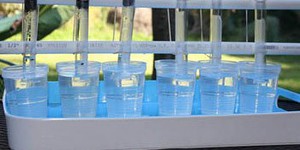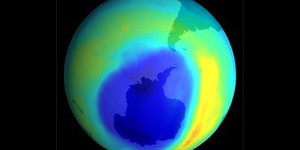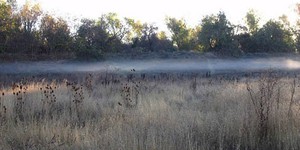Eighth Grade, Weather & Atmosphere Science Projects (18 results)
Everybody talks about the weather, but nobody does anything about it.
- Charles Dudley Warner
Weather and atmospheric science offer lots of opportunities for interesting explorations. It's a satisfyingly complex area, with lots of online resources so you can make your project as easy or as advanced as you want. And when you're done, you'll have a science fair project everyone can talk about.
|
Select a resource
Sort by
|
Earth's atmosphere, the ocean of air that blankets the planet, is mostly nitrogen and oxygen, with small amounts of other gases. How much oxygen is present in air at sea level? In air high up in the Appalachians or Rockies? Atop Mount Everest? How much oxygen is present in the air you breathe? Here's a project that shows you how to measure the percentage of oxygen in an air sample.
Read more
Featured
Have you heard that garlic powder is supposed to inhibit the growth of bacteria? Which do you think would make a better disinfectant: a solution of garlic powder or a solution of bleach? This project shows you a straightforward way to compare the effectiveness of different disinfectants (or other antimicrobial agents), by measuring zones of inhibition on a culture plate.
Read more
Does your hair go crazy when the weather turns damp? Did you know that strands of hair can relax and lengthen when the humidity increases and then contract again when the humidity decreases? In fact, hair strands can be used as the basis for a hygrometer, a device which measures the humidity level in the air. Will a hygrometer help you to predict bad hair days(!) or can you use it to help predict the weather?
Read more
New
Engineers are trying to tackle the world's ocean pollution problem using robots. Some robots, like Mr. Trash Wheel and the ship featured in this Mark Rober video, are stationary and collect trash as it flows out of rivers before it gets into the ocean. Others, like the Jellyfishbot, are mobile and can squeeze into narrower spaces to collect trash:
Can you build and test your own trash-skimming robot? If you do not have access to a natural body of water to test it in, you can use a bathtub or a…
Read more
Before you head for school for the day, you might check the weather to see whether or not you need to wear a jacket or bring an umbrella. It is pretty easy for you to check the TV or internet to see what the weather will be like today, tomorrow, or even next week. The modern-day science of meteorology, or studying and predicting the weather, has many advanced tools at its disposal that make it easy for you to get this information.
How did people predict the weather before the invention of…
Read more
The ozone layer is important for blocking most of the harmful radiation that comes from the sun. You can find maps of the ozone layer and compare different regions of the globe for ozone coverage. Where are the problem areas? Is there a difference in ozone coverage between different hemispheres? Between populated and un-populated areas? In atmospheric regions over land masses or over bodies of water? Some scientists think that aerosols in the air are breaking down the ozone layer. You can do…
Read more
Unless you live in the Southern states, you only hear about the most destructive hurricanes. In fact hurricanes occur every year, even multiple times a year. Each hurricane is a tropical storm related to cyclones and tornadoes, some big and some small. Each hurricane is measured based upon several variables like: wind speed, diameter, direction of movement and speed of movement. Does the size of the hurricane correlate with the wind speed? What information can the eye of the hurricane…
Read more
New
Drones are small, fast, and maneuverable - this can make them very hard to knock down! Check out this Mark Rober video where he explores both how professional defense companies and some backyard YouTube engineers tackle the problem of knocking drones out of the sky. Can you take this engineering challenge on yourself? What methods can you devise to take down a drone? Which one works the best?
Drones can be expensive, and you probably do not want to risk damaging a $1,000 drone for your science…
Read more
Floods can be very destructive, capable of leveling whole towns and decimating crops and fields. Typically in regions prone to flooding there are cycles of flooding that occur, usually in areas where a wet season comes after a period of drought. You can use precipitation data to test if incidents of flooding have been preceded by periods of drought. Look for long periods of dryness in the precipitation data to indicate a drought. You can also conduct an experiment on dry or moist soil to see…
Read more
How does temperature change as barometric pressure changes? You can make a device to test this using a barometer and a thermometer on your stovetop. You can collect your own weather data from a barometer and thermometer over a period of a week or month. You can also use data from a weather station to plot the relationship between barometric pressure and temperature. Does the pressure change as humidity changes? Measure the pressure in a humid and non-humid environment (like your bathroom…
Read more
Many continents contain large mountain ranges that divide the continent into different regions. In the U.S. the Rocky Mountains mark the continental divide. The presence of a large mountain range can have a big effect on seasonal weather patterns. Also, the weather and climate on one side of a mountain range may be very different from weather and climate on the other side of the range. In the case of the Rocky Mountains, the western slope and eastern slope each have very different climates…
Read more
You can investigate how the geography of an area makes it prone to severe flash floods. Some areas, typically gullies or canyons, can flood extremely rapidly making it impossible to escape a flash flood. Compare the topography, or geographical shape, or these areas. What makes them prone to flash floods? Can you do an experiment showing how the flow of water increases as a channel narrows? Can you use topological maps of your region to identify areas at risk for flash floods? (NCAR, 2006;…
Read more
The poet Carl Sandburg wrote, "The fog comes on little cat feet..." In this weather science fair project, you'll discover why this beautiful, quiet creeper appears on some days, and not on others. If you are fascinated by fog and weather conditions, this science fair project is for you!
Read more
|
Explore Our Science Videos
Can You Drink From a Really Long Straw?
Make 3D Printed Fabric
Make Fake Snow - Craft Your Science Project












